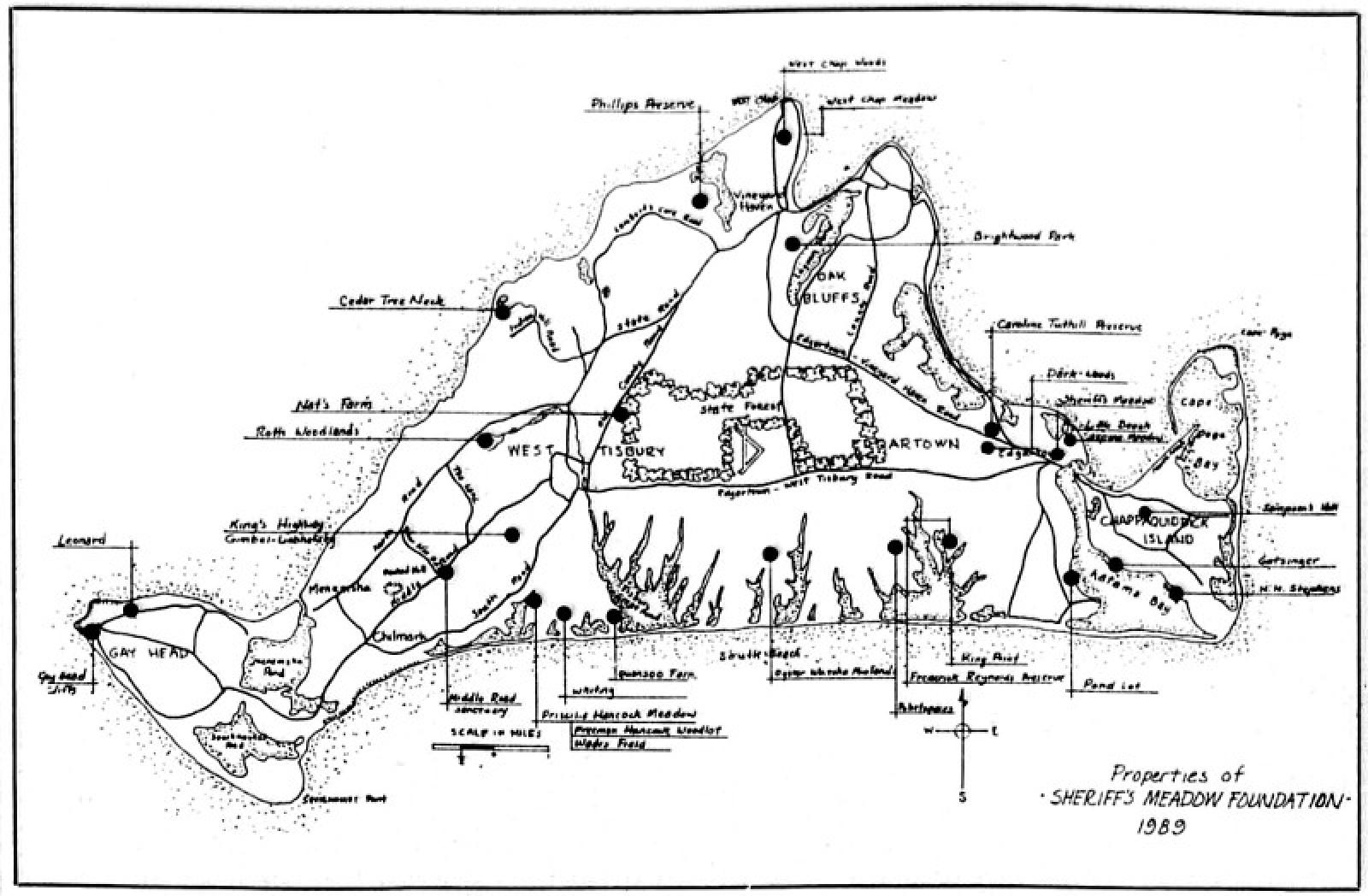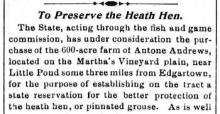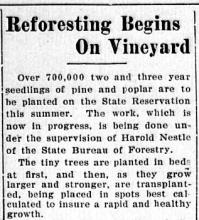The Sheriff's Meadow Foundation, now celebrating its 30th anniversary, owes its existence to the vision, courage and determination of two remarkable people: the late Henry and Elizabeth Hough. In 1920, Henry's father gave the Vineyard Gazette as a wedding present to the two young graduates of the Columbia School of Journalism. Active as managing editor of the New Bedford Evening Standard, the father had introduced Henry to the exciting possibilities of small-town community journalism.
Founded in 1846, the Gazette had a circulation of 528 by 1926. The early years were hard and precarious. The new owners were convinced that “circumstanced as well as choice made us an Island newspaper and kept us, refusing to meddle editorially with national or state politics unless we saw them coming ashore at the steamboat wharf or approaching along the street.”
Through his childhood years at Fish Hook in North Tisbury, Henry Beetle Hough (his mother was a Holmes Hole Beetle) was rooted in the Vineyard. Betty Hough's childhood lay in the Pennsylvania mountains, but she soon succumbed to the lure of the Island. Both were fascinated by the variety of people found on the Vineyard and both were most sensitive to its landscape.
In 1928, the Houghs built their own house which backed onto the lane leading to Sheriff's Meadow, where a stone dike converted an old marsh into a pond big enough to cut marketable ice in hard winter. Thee northern outlook from the Hough house was dominated by an immense, high-shouldered icehouse. When the winter allowed, the ice was sawed into big squares which an ancient gasoline engine managed to hoist into the icehouse for storage.
A succession of mild winters and the electric refrigerator did Sheriff's Meadow out of its market. The icehouse soon collapsed, leaving the Houghs with an uninterrupted view across John Butler's mud hole, Eel Pond and Vineyard Sound over to the Cape.
Concerned lest this familiar prospect be somewhat ruined, Betty Hough negotiated the purchase in 1958 of the 10 acres of the pond and the field around it for the $7,500 which Henry had just made by selling the magazine rights to Once More the Thunderer, his second newspaper book. What to do with this private sanctuary became an immediate problem. None of the larger conservation groups would take on such a small sanctuary, except with a sizable endowment. Yet all recognized that the importance of the meadow and its pond was all out of proportion to their size. The only solution seemed to lie in their own charitable corporation.
With the help of Judge Arthur Davis, for $90 worth of legal services, the Sheriff's Meadow Foundation was created and chartered by the state on April 2, 1959, setting out as only Henry Hough could the purposes, hopes and plans of the Foundation: “to preserve, administer and maintain natural habitats for wild life on Martha's Vineyard for educational purposes and in the interests of conservation; to acquire, receive, and protect such natural areas so that they may serve as living museums and as a means of assuring to the future generations a knowledge of the natural endowment of Martha's Vineyard; and to cooperate with other agencies in the field of education and conservation to further their aims as much as possible in the public interest.”
Over the next few years the Houghs, with the help of their neighbors, enlarged the original Sheriff's Meadow holding to almost 15 acres which included a rich seasonal variety of birds, animals and plants. In 1965 Betty Hough died, just two years before the Foundation began expanding its holdings, eventually to include properties all over the Vineyard. The editors had always advocated a reasonable program of such necessary improvements as better roads, but first on the list came “the preservation of the natural endowment of Martha's Vineyard.”
The first addition came in North Tisbury, where Henry and his brother had inherited Fish Hook, 60 acres and a quarter of a mile of beach on the Sound. When Henry realized that their heirs would have to sell most of the property to pay the inheritance taxes, again the Foundation seemed the only answer. Their neighbors, the Daggett family, faced the same dilemma: how to preserve almost 200 acres and even more shore bordering the impressive bluff of Cedar Tree Neck?
In 1967 Henry Hough organized a campaign to save as much as possible of this natural museum and refuge for the public. The Houghs kept Fish Hook and other houses, and retained a life interest in the rest, which was then given to the Foundation. The Daggetts kept the homestead and 10 acres, selling the rest to the Foundation. Neighbors and friends came through with adjacent land and money.
Cedar Tree Neck, now the Daggett Sanctuary, increased the Foundation's holding over tenfold. A system of trails was introduced in 1978 a cottage was built for the custodian.
Successfully launched, Sheriff's Meadow Foundation grew dramatically over the next decades. By the end of 1973 the Foundation had received 750 acres. By the end of 1986 its holdings totaled more than 1,718 acres. The Foundation was preserving precious property from Gay Head to Chappaquiddick. In addition, it accepted the responsibility of enforcing conservation restrictions on another 220 acres of land.
Perhaps the simplest explanation for this growth is that an increasing number of people who may have received or acquired property on the Vineyard shared Henry's concern to protect natural areas “to serve as a living museum.” Although other, larger conservation organization were readily available (some already with properties on the Vineyard), Sheriff's Meadow was Island-based and had a brilliant spokesman in Henry Hough. Local zoning made gifts easy to work out and IRS regulations, often advantageous. Finally, Island residence can make anyone truly appreciate the degree to which the environment – land, water, fauna and flora – is fragile, threatened and finite.
Four the Foundation the decision to accept a piece of property is not simple. Every offer must be decided on its own merits:
What is the intrinsic importance of the parcel as a sanctuary? What makes it worth preserving?
Where is the property on the Vineyard, especially in relation to the Foundation's other holdings?
Does the intent of the donor coincide properly with the purpose and program of the Foundation?
Preservation remains of first importance. Increasingly on an Island whose most active industry is tourism, public pressures must often be resisted. Therefore swimming, picnicking, camping and gunnery are prohibited. Public use can easily fall into misuse and the loss of a precious resource for the future. To hew the fine line between human enjoyment and human abuse is never easy.
In 1983, two years before he died, Henry Hough defined his Foundation as “We're free and independent, and we act.” Time and change are making that ideal more difficult to achieve.
Mr. Mendenhall is a resident of West Tisbury, former president of the Sheriff's Meadow Foundation, and a contributor to the Vineyard Gazette.










Comments